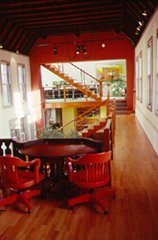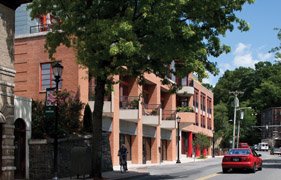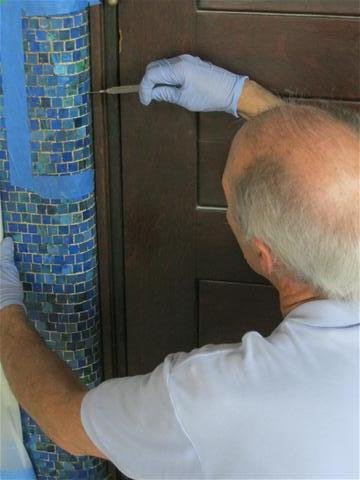A Conversation with Architect Stephen Tilly
The firm Stephen Tilly, Architect, has been based at 22 Elm Street, Dobbs Ferry, since 1988. Renowned for its restoration efforts, the company has worked on guidelines for historic districts and homes in Dobbs Ferry, Irvington, Ossining, Yonkers, and New Rochelle as well as other locations. Tilly, who has been an architect since 1978, is a Certified Passive House Consultant, and his firm is a member of the Association for Preservation Technology. He spoke with the Neighborhood Buzz about restoration work in and near the Rivertowns.
NB: How much of your firm’s work is in restoration?
Maybe 50 percent. Sometimes it’s more than that; sometimes it might be a little less. A very large percentage of our work—75 percent—is working with existing buildings. That’s something we like to do and something that we believe in because most of the buildings that are going to exist by the end of the century are existing buildings.
NB: Is restoration big in the Rivertowns?
The river villages have essentially been built out since the 1940s, and there’s a certain amount of resistance to demolition and new construction, especially in neighborhoods. So certainly, renovation and sympathetic renovation are pretty widespread. There are a limited number of historic sites, and we’ve worked on quite a few of them. We get called in especially on the restoration side when there’s something that has special status and requires special skill.
NB: What periods or architectural styles are prevalent?
There’s a tremendous variety, and that’s what’s fun. There are styles from Federal and fairly early Colonial to Mid-Century Modern and, since then, the post-war split-level ranch houses. There are also styles from people who worked with Frank Lloyd Wright to lots of Victorians and post-Victorians.
Read articles from current and all previous issues of The Neighborhood Buzz: Rivertowns, plus receive a printed copy of the magazine every 3 months.
NB: Is this a particularly interesting area to do restoration?
You don’t get stuck in a rut, and there are interesting examples of things that may not have been recognized as important by everybody but that you can discover. There’s certainly been a long history of occupation and development all the way back to before the Revolutionary War. We’re working on a building in Greenburgh that was started in the 1730s and was occupied until the mid-twentieth century. It’s the Odell House Rochambeau headquarters. It was where the Comte de Rochambeau camped out. He met with George Washington there and they schemed this pretend attack on New York to draw the British out so they could sneak across the Hudson and go down to Yorktown, where there was a decisive battle. This site was where the French soldiers from Rhode Island camped out, and not far away was where Washington camped out. We’re working with the town of Greenburgh and restoring it.
NB: You also did the Dobbs Ferry Library. Was that considered restoration?
We worked on the old library at the corner of Cedar and Main Streets, which was designed by Bertram Goodhue, who also had something to do with my building here. It’s an old theater. Bertram Goodhue was a well-known architect who did work all around the country—the Nebraska State Capitol and major churches in Manhattan. We’ve worked on other libraries, including the Warner Library in Tarrytown, restoring the entrance and taking off a dropped ceiling and revealing this beautiful ceiling in the reading room. It’s a late nineteenth-, early twentieth-century, beautiful Colonial Revival ceiling with moldings, and we were able to put hanging light fixtures there.
When we were working in Manhattan at the Congregation Shearith Israel Synagogue at 70 Street and Central Park West, we opened up a Tiffany window in the women’s bathroom by taking off the dropped ceiling. It’s always very cool to reveal something that people didn’t know was there.
NB: What major projects are you undertaking in the Rivertowns?
We’re working on Villa Lewaro in Irvington. We’ve been restoring it since 2018. It’s the former home of Madam C.J. Walker, the first Black millionairess in the country. Our client is a nonprofit that bought the Madam C.J. Walker brand of hair care, and the site is going to be a center for women entrepreneurs of color. We’re slowly restoring that and going through a permit process. Also, in the Rivertowns, we’re always working on single family residences.
Read articles from current and all previous issues of The Neighborhood Buzz: Rivertowns, plus receive a printed copy of the magazine every 3 months.
NB: Is it difficult to restore buildings from the 1700s and 1800s and meet current building codes?
Yes. You have to know a lot more to do this kind of work than to do new buildings. In dealing with a historic building, there’s a slightly different code called the Existing Building Code, and the process is complex. You have to make every effort to make it accessible, to make it safe to occupy, but the techniques for doing so cannot destroy the building. Luckily there are new technologies. We have been working for many, many years at Lyndhurst Mansion, and we added what’s called mist fire prevention. It includes smaller pipes than a commercial fire system, and we were able to conceal heads.
NB: Is restoration a “green” process?
The most sustainable thing we do is keep existing buildings in place. The environmental impacts of demolishing an existing building and then building a new building, no matter how green it is, [are greater than what can be compensated for] within the time period that we have to reduce our carbon emissions. So new green buildings don’t really help. What really helps is that every time we get our hands on an old building, we’re reducing its carbon footprint and saving the carbon footprint of demolition.
Read articles from current and all previous issues of The Neighborhood Buzz: Rivertowns, plus receive a printed copy of the magazine every 3 months.
NB: Are there materials in older buildings that are hard to find or match?
Yes, chestnut. You can’t get any more unless you can find something that was made of chestnut and you can salvage it. You’re sometimes substituting one species for another, and [there are] other places where you have to make strategic decisions about how well the building will be maintained.
At the South Presbyterian Church in Dobbs Ferry, there’s a house on the corner that’s associated with the Days of Wonder Daycare Center. Very high up, there were wood moldings covered with lead paint and they had to be remediated. We had molds made, and we put fiberglass back because we realized that churches generally don’t have a lot of money for maintenance. With something that’s that far away, we figured we could use fiberglass and it would still be considered respectful and considerate of the history. So, there are substitute materials, as long as you’re careful about their use, that have a longer life than some of the original materials.
Sometimes we have to improve on the original construction methods where it’s not highly visible [for instance] to stop moisture from getting at the kind of informal foundations that were often built in the eighteenth century. They’d put beams on a pile of rocks. We try to put some membrane on the ground so that the moisture doesn’t get into our framing members. There are a lot of technical issues to be solved.
NB: What’s one major point you would like people to know?
My big message is that this is a sustainable activity, and we want to keep existing buildings in place. But they’re not exempt from being upgraded. Existing buildings are 40 percent of our national carbon footprint, and we really need to pay attention to them but also keep them in place, because construction debris is also a very big percentage of our waste stream.
Congregation Shearith Israel - Restoration of columns.












